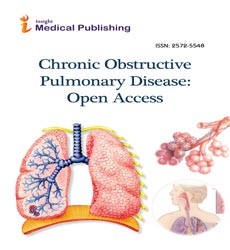Abstract
Impact of chronic obstructive pulmonary disease, lung infection, and/or inhaled corticosteroids use on potential risk of lung cancer
Chronic obstructive pulmonary disease is the 3rd leading cause of death worldwide. It not only affects current and former smokers, but non-smokers as well. Chronic inflammatory response in this disease state leads to the production of genotoxic free radicals and reactive oxygen species that could result in tumorigenesis. Inhaled corticosteroids are used for the management of inflammation in patients experiencing frequent exacerbation and/or have a high eosinophil count. However, these steroids are often prescribed off-label for symptom management. Using inhaled corticosteroids to combat inflammation in chronic obstructive pulmonary disease patients is suggested to be protective against lung cancer. However, immunomodulatory effects of these medications can pre-dispose patients to develop respiratory infections such as tuberculosis or pneumonia. These lung infections have shown to also increase the risk of developing lung cancer. Since chronic obstructive pulmonary disease is an independent risk factor for developing lung cancer, a subsequent infection could have an additive effect. Additionally, the aforementioned chemo-preventive effects of inhaled corticosteroids are inconsistent due to there being limited data on the long term effects of using inhaled corticosteroids in patients who do not meet the treatment recommendation guidelines. Hence, it is necessary to recognize the indirect connection between inhaled corticosteroids and lung cancer possibly via lung infections in chronic obstructive pulmonary disease patients. The rationale behind this review is to better understand the mechanistic links that connect these multiple disease states which could aid in guiding treatment with inhaled corticosteroids in specific subgroups. This review discusses possible pathways that could lead to the lung carcinogenesis and the cumulative impact of chronic obstructive pulmonary disease, inhaled corticosteroids use, and pulmonary infections on the risk of lung cancer.
Author(s): Ianne Jireh N
Abstract | Full-Text | PDF
Share this

Awards Nomination
Google scholar citation report
Citations : 130
Abstracted/Indexed in
- Google Scholar
- China National Knowledge Infrastructure (CNKI)
- Publons
- Geneva Foundation for Medical Education and Research
- Secret Search Engine Labs
Open Access Journals
- Aquaculture & Veterinary Science
- Chemistry & Chemical Sciences
- Clinical Sciences
- Engineering
- General Science
- Genetics & Molecular Biology
- Health Care & Nursing
- Immunology & Microbiology
- Materials Science
- Mathematics & Physics
- Medical Sciences
- Neurology & Psychiatry
- Oncology & Cancer Science
- Pharmaceutical Sciences

